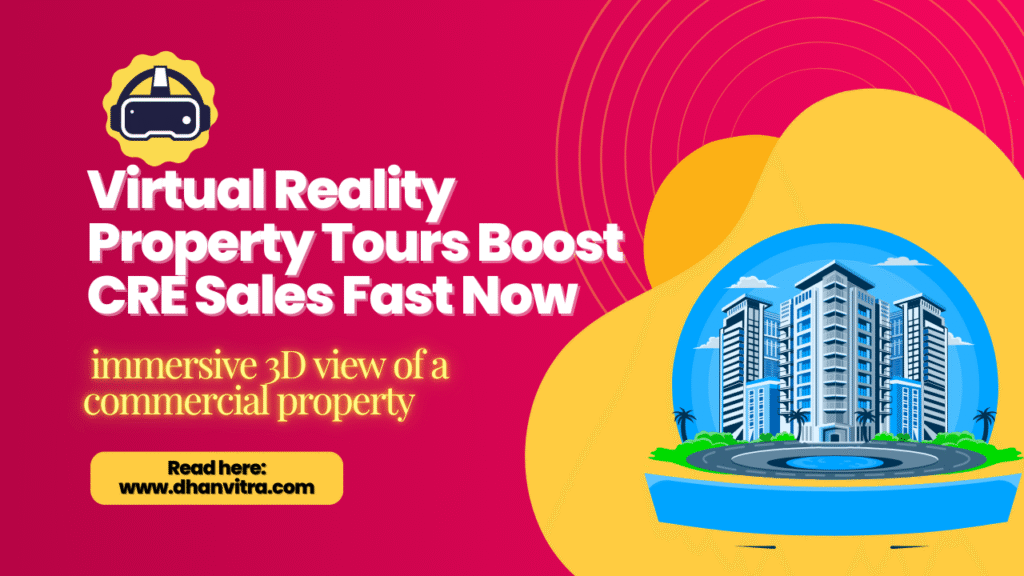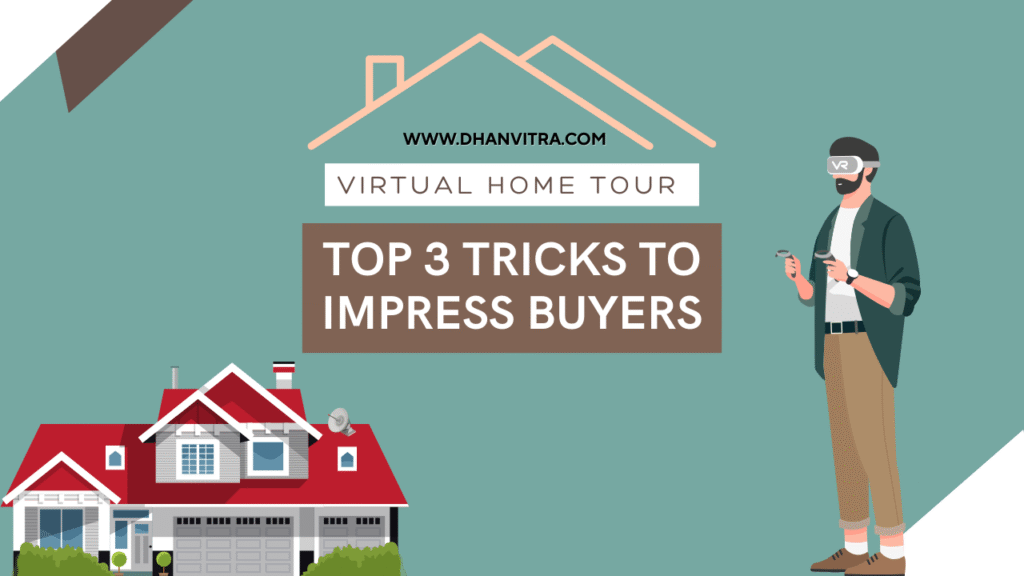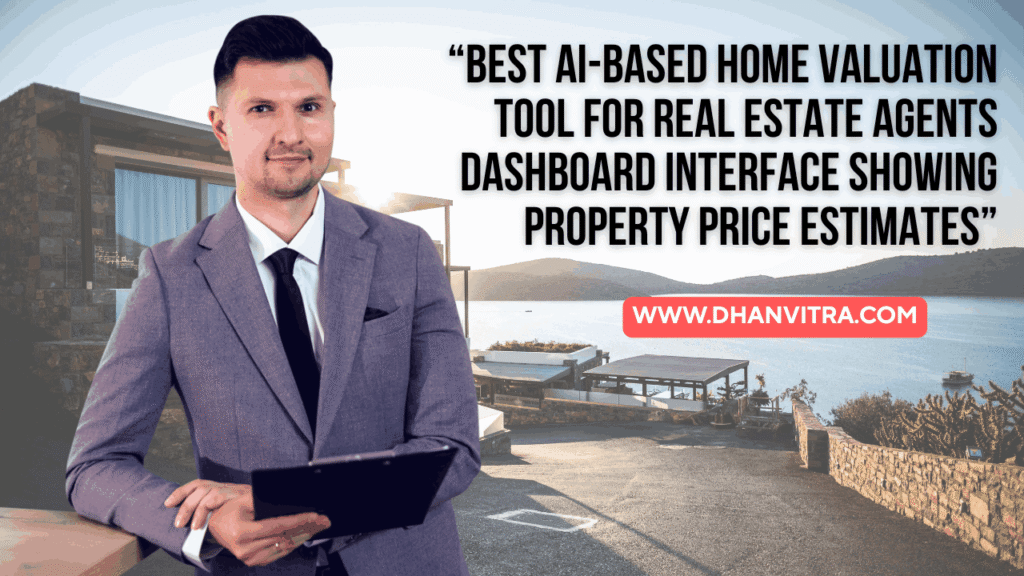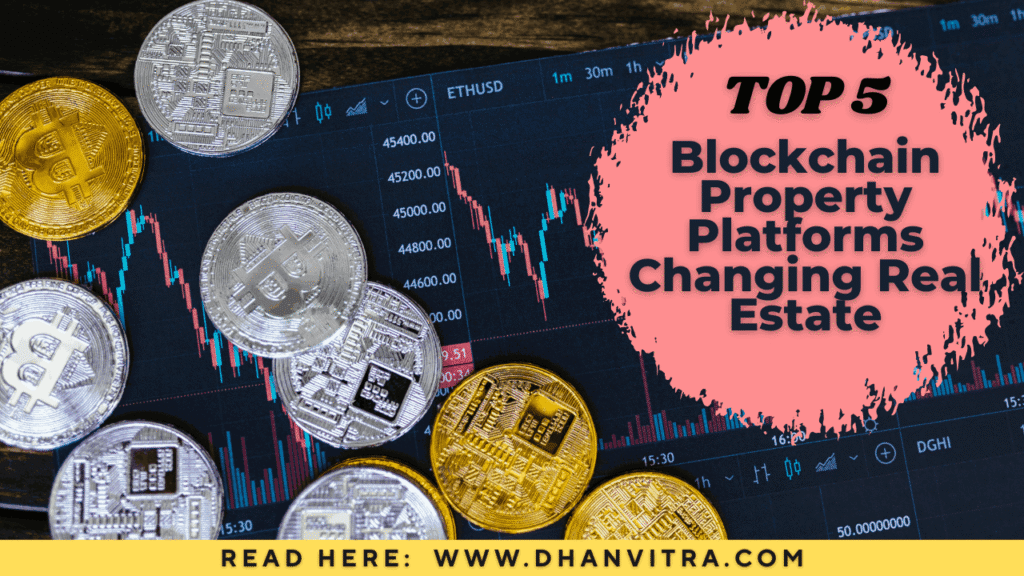
Welcome to Dhanvitra, your trusted hub for the latest trends and innovations in the commercial real estate (CRE) world. In today’s fast-paced market, buyers and investors are looking for smarter, faster, and more engaging ways to explore properties. Traditional property tours, with their limited photos and time-consuming site visits, often fail to meet expectations.
This is where Virtual Reality Property Tours step in to revolutionize the CRE experience. Imagine being able to walk through a premium office space, a retail complex, or a luxury apartment without leaving your home—or even across the globe. VR technology transforms static listings into immersive experiences, allowing potential buyers to truly “feel” the property before making any decisions.
On this blog, we delve into how VR is transforming the commercial real estate landscape, enabling agents to close deals more efficiently, connect with international clients, and drive sales to new heights. If you’ve ever wondered how technology can supercharge property marketing and elevate client experiences, you’re in the right place.
Table of Contents
What Are Virtual Reality (VR) Property Tours?
Virtual Reality property tours are a revolutionary approach to showcasing commercial real estate. Unlike traditional methods, where potential buyers rely on photographs, brochures, or physical visits, VR tours immerse clients directly into a property environment. Think of it as stepping inside a space without physically being there. Using VR headsets, web browsers, or even mobile devices, viewers can navigate through every corner of a property, move from room to room, and experience the true scale and design.
The technology behind VR property tours combines high-resolution 3D imaging, 360-degree photography, and spatial audio to create a realistic simulation. For commercial properties, this means investors can inspect offices, retail spaces, warehouses, or industrial sites in precise detail. They can gauge room dimensions, furniture layouts, lighting conditions, and even architectural nuances. VR tours are not just visually compelling—they provide an experiential understanding that photos and videos often fail to deliver.
What makes VR property tours even more impressive is interactivity. Clients can click on features, open doors, adjust furniture layouts, or even explore different interior design styles. This interactive component transforms the property viewing experience from passive observation to active exploration, significantly increasing engagement and interest.
The Rise of VR in Commercial Real Estate
The adoption of VR in commercial real estate has been nothing short of transformative. Over the past few years, CRE companies worldwide have embraced VR as a tool to adapt to changing client behaviors, technological advancements, and a globalized property market. Investors and clients no longer want to rely solely on photographs or second-hand descriptions—they want a tangible sense of the property’s potential.
Several factors are fueling the rise of VR in CRE. First, the demand for remote property viewing has skyrocketed. International investors, especially in prime urban markets, need to assess properties without traveling extensively. VR provides a solution that saves time and travel costs while offering a rich, immersive experience. Second, technological advancements have made VR tools more accessible and cost-effective. High-quality 3D imaging, photorealistic rendering, and even AI-powered virtual staging have enabled CRE firms to create stunning VR experiences quickly.
Global examples abound. Cities like New York, London, Singapore, and Dubai have seen top CRE agencies integrate VR tours into their marketing strategies. In Asia and Europe, VR has been instrumental in accelerating deals for high-value office spaces and luxury retail outlets. The trend is clear: VR is no longer a futuristic gimmick; it’s becoming a standard expectation in modern commercial real estate.
Benefits of VR Property Tours for CRE
VR property tours bring a multitude of benefits that directly impact sales, client engagement, and operational efficiency in commercial real estate. One of the most significant advantages is enhanced property visualization. Instead of imagining how a space might feel based on 2D photos, clients can virtually step inside the property, understand its flow, and see its true potential. This level of clarity reduces confusion and builds confidence in purchasing decisions.
Another key benefit is increased engagement. Traditional property listings often lose potential buyers’ attention after a few images or a brief video. VR tours, however, captivate clients by allowing them to actively explore the property. The immersive nature encourages longer interaction times, giving agents more opportunities to highlight unique selling points and features.
Furthermore, VR extends the property’s reach globally. Investors from anywhere in the world can tour properties at their convenience, overcoming geographical limitations. This wider accessibility opens the door to international deals, cross-border investments, and faster sales cycles. In essence, VR doesn’t just enhance viewing; it transforms the CRE market by connecting sellers with a global pool of buyers efficiently and effectively.
How VR Improves Buyer Experience
From a buyer’s perspective, VR property tours redefine the property search journey. Interactivity is the cornerstone of this enhanced experience. Unlike static photos or guided in-person tours, VR allows clients to control their exploration. They can move at their own pace, focus on areas that matter most, and revisit spaces multiple times. This self-directed navigation empowers buyers, giving them confidence that they fully understand the property before committing to a deal.
Personalization further elevates the buyer experience. Some VR platforms enable potential clients to modify interiors, experiment with different layouts, or virtually stage spaces to match their vision. This level of engagement helps buyers see the property’s true potential, reducing uncertainty and increasing emotional attachment.
Additionally, VR provides instant feedback and information. As buyers navigate, they can access detailed descriptions, pricing, and other specifications in real-time. This immediacy streamlines the decision-making process, shortening the sales cycle and reducing back-and-forth inquiries. In effect, VR tours make property buying not just easier, but more enjoyable and immersive, creating an experience that feels almost magical compared to traditional methods.
Boosting Sales Through VR Tours
Virtual reality has revolutionized the way commercial real estate professionals close deals. Traditional property tours can be slow, expensive, and geographically limited, but VR tours eliminate these barriers. By giving prospective clients the ability to explore properties virtually, CRE agents can dramatically shorten the sales cycle. Imagine a client in Tokyo inspecting a property in New York in real time, navigating rooms, checking layouts, and even visualizing future renovations—all without leaving their office.
VR tours also enhance emotional engagement. When clients feel immersed in a space, they begin to form a stronger connection to it, which naturally increases the likelihood of a purchase. For developers and agents, this translates into faster lead conversion and more competitive positioning in the market. Some CRE firms report sales increasing by 20% to 40% after implementing VR tours because potential buyers can make confident decisions quickly, often without the friction of repeated in-person visits.
Cost-Effectiveness of VR Tours
While VR technology might seem like a high-end investment, it often proves far more cost-effective than traditional methods in the long run. The savings come from multiple angles. Travel expenses for client visits, repeated open houses, and extensive property staging can quickly add up, especially when clients are international or spread across multiple cities. VR tours reduce or eliminate many of these costs by offering a fully immersive property experience online.
Marketing expenses also see a reduction. Instead of relying on high-budget photoshoots or print materials, one high-quality VR scan of a property can be used for months or even years, reaching an unlimited number of prospects. The return on investment becomes clear when comparing the upfront technology costs to the time and resources saved. For many commercial real estate firms, the VR setup pays for itself within the first few deals because of the accelerated sales process and reduced operational overhead.
VR Tools and Platforms for CRE
The VR ecosystem for commercial real estate is diverse and growing rapidly. There are platforms designed specifically for CRE, offering tools like 3D walkthroughs, interactive floor plans, and even virtual staging. Popular solutions range from simple browser-based tours to advanced VR headset experiences.
High-end platforms allow clients to measure spaces, change wall colors, and even customize furniture layouts in real time, making the experience deeply interactive. Some software integrates with CRM systems to track client engagement, providing agents with valuable insights on which features attract the most attention. Affordability varies, but many solutions are scalable, meaning small agencies can start with basic tours and gradually upgrade as their needs grow.
Challenges and Limitations of VR in CRE
Despite its numerous advantages, VR adoption comes with certain challenges. One major hurdle is technological accessibility. Not all clients have VR headsets or high-speed internet capable of running immersive tours smoothly. In addition, creating high-quality VR content requires technical expertise, specialized equipment, and careful planning. Poorly executed VR experiences can backfire, leaving potential buyers frustrated instead of impressed.
Data privacy and security are also concerns. Sensitive property information, floor plans, and client interactions must be carefully protected. CRE firms need to implement strict protocols to ensure that virtual tours don’t become a source of data leaks. Finally, there’s a learning curve—both agents and clients must adapt to navigating virtual environments, which can slow adoption in certain markets.
Future Trends in VR Real Estate Tours
The future of VR in commercial real estate looks incredibly promising, with several innovations on the horizon. Artificial intelligence is beginning to play a role, offering predictive analytics that can suggest properties to clients based on their preferences and browsing behavior. Virtual staging is becoming more sophisticated, allowing clients to see potential renovations or design changes in real time, making properties feel personalized before any physical work begins.
Mixed reality and holographic experiences are also entering the market, enabling hybrid interactions where physical and virtual elements blend seamlessly. Imagine walking into a partially built office space and seeing holographic projections of furniture, lighting, and interior layouts instantly. These trends suggest that VR won’t just be a sales tool—it will become an integral part of how clients experience, evaluate, and commit to commercial properties.
Tips for Implementing VR Tours Successfully
Implementing VR property tours isn’t just about buying a headset and scanning spaces. The key to making these tours impactful lies in meticulous planning, high-quality content creation, and strategic client engagement. Start by investing in top-tier 3D imaging technology. A low-resolution tour can break the immersive experience and leave clients unimpressed. Think of it like creating a blockbuster movie—you need crisp visuals, seamless transitions, and attention to detail to hold the audience’s attention.
Next, it’s essential to train your agents and sales team to navigate these VR tools. A client is more likely to engage fully when guided by someone confident in the technology. Agents should understand how to highlight property features dynamically, answer questions while navigating the virtual space, and customize tours to a client’s specific interests.
Marketing VR tours effectively is another vital step. Unlike traditional listings, VR experiences can be shared online, allowing clients across continents to explore your property. Highlight the interactive elements in your marketing campaigns, showing prospects that they can virtually walk through, measure spaces, and even visualize furniture placements. This adds excitement and sets your listings apart in a competitive global market.
Lastly, feedback loops are invaluable. Collect data on how users interact with your VR tours—what areas they spend the most time in, where they drop off, and what questions they ask. This insight allows you to refine your VR presentations continually, ensuring every tour maximizes engagement and drives conversions.
VR and Global Market Expansion
Virtual reality has the power to break down geographical barriers, giving commercial real estate firms access to an international audience that traditional methods can’t reach. Investors, tenants, and buyers no longer need to travel physically to explore properties. They can experience spaces in rich, immersive detail from anywhere in the world.
This capability is particularly transformative for high-value CRE markets. A luxury office tower in New York or a commercial retail space in Dubai can now attract investors from Tokyo, London, or Sydney within minutes. The ability to provide a realistic, interactive experience eliminates many of the uncertainties and risks associated with international property investment.
Moreover, VR tours enable cross-border transactions to be faster and more efficient. Legal teams, investors, and stakeholders can review spaces virtually before committing, reducing delays caused by time zones or travel constraints. For developers and brokers, this opens a new avenue for expanding their portfolio globally while maintaining a personalized client experience. In essence, VR doesn’t just enhance property tours—it creates a truly global marketplace where opportunities are accessible to anyone, anywhere.
Comparing VR Tours vs Traditional Tours
Virtual reality tours and traditional property visits each have their merits, but the differences in speed, engagement, and overall impact are striking. Traditional tours are limited by geography, time constraints, and the subjective experience of each visitor. Clients may forget details or miss critical features, leading to delayed decisions or lost sales.
In contrast, VR tours provide an interactive, repeatable, and highly detailed walkthrough of the property. Prospective buyers can revisit the space multiple times, inspect corners they might have overlooked in person, and make more informed decisions faster. Unlike static photos or videos, VR offers an emotional connection—clients feel like they are “living” in the space rather than simply observing it.
That said, VR doesn’t entirely replace traditional tours; it complements them. While VR creates initial excitement and filters serious prospects, physical visits remain important for tactile elements like texture, lighting nuances, and local surroundings. Combining both approaches creates a hybrid model that maximizes reach, efficiency, and client satisfaction, ultimately boosting conversion rates.
Conclusion
Virtual reality property tours have reshaped the commercial real estate landscape, offering unprecedented opportunities to engage clients, shorten sales cycles, and expand into global markets. From immersive walkthroughs to interactive marketing, VR transforms how properties are presented, making them more accessible, captivating, and conversion-friendly.
By implementing VR tours strategically, training agents effectively, and leveraging the technology to reach international audiences, CRE professionals can position themselves at the forefront of innovation. While traditional tours remain valuable, VR provides a scalable, modern solution that meets the evolving demands of global buyers and investors. In today’s competitive market, embracing VR isn’t just a technological upgrade—it’s a necessity for fast, efficient, and successful property sales.
FAQs
How much does a VR property tour cost?
Costs vary depending on the property size, software, and level of detail. Basic tours start from a few hundred dollars, while premium, fully interactive 3D experiences can reach several thousand dollars.
Can VR replace physical property visits entirely?
While VR is powerful, physical visits are still important for tactile and environmental assessments. VR works best as a complementary tool to filter serious prospects.
Are VR tours effective for all property types?
Yes, from office buildings and retail spaces to industrial properties and luxury apartments, VR tours can enhance engagement for virtually any commercial property.
How quickly can VR boost CRE sales?
Firms often see faster lead conversion and shorter sales cycles within weeks of implementing VR tours, especially in competitive markets.
What technology is required for clients to access VR tours?
Clients can use VR headsets, smartphones, tablets, or even desktops with web-based VR solutions, making it accessible to a broad audience globally.









